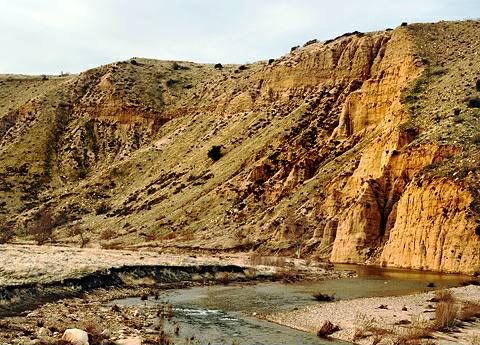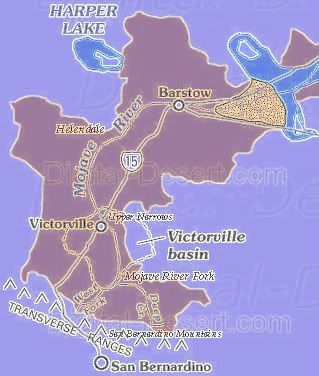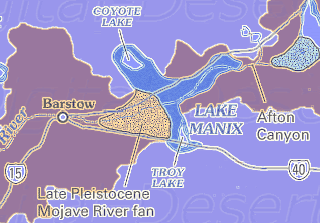High
Desert Geology
-Mojave
River-


 The High Desert's First Earthcache and My
100th Cache Hide
The High Desert's First Earthcache and My
100th Cache Hide


The
Mojave River is the largest drainage system in the Mojave
Desert.
It has been nicknamed the "Upside-Down and Backwards" river.
"Upside-
Down" because the water flows primarily underground.
"Backwards" because
the
water flows North, away from the Ocean, instead of South towards
the
Ocean as most rivers do.

The
Mojave River currently flows North due to Geological events. The
Mojave
River system began developing as Westward-Flowing
streams were blocked
by the uplift of the
Transverse Ranges along the greater San Andreas
Fault.
The Transverse
Ranges, the local San Bernardino Mountains, represent
a
complex of tectonic
forces stemming from the interaction of the Pacific
Plate
and the North American Plate along the San Andreas
Fault System. As
Tectonic forces drove
the Pacific Plate under the North American Plate,
the
North American Plate
lifted upward creating the Transverse Ranges and
a
northern slope that
redirected water runoff away from the Ocean and North
to
the Desert. With the
San Andreas fault pushing the mountains up,
slowing
general drainage of
the area, the Victorville Basin became a marshland
for
many years before the
Mojave River reversed direction
inland.
Chronology of the Ancestral Mojave
River
11 - 10
million years ago: The region sloped toward the
Pacific Ocean
8 - 7.6
million years ago: Birth of ancestral Transverse
Ranges (San Gabriel fault)
3.5 million
years ago: San Gabriel Mountains rise
blocking the slope to the
ocean and
forming marshlands. Ancestral Deep Creek coming out of the
San Bernardino Range begins to appear.
2.5 - 2 million years ago: Continued rise of the San
Bernardino Range
along the San Andreas fault reverse the regional drainage
direction.
1.5 - 1 million years ago: The development of faults further
to the north and
east.
500 thousand years ago: Appearance of perennial lakes
Harper and Manix
70 - 80 thousand years ago: Ancestral Mojave River develops
as an incised channel with a
course.

The Mojave River originates in the
Upper Watershed of
the San
Bernardino
Mountains. This area comprises less than 5% of the total
drainage basin area
yet it accounts for more than 95% of the total basin
precipitation. Its
ephemeral waters, or
episodic-lasting a short duration, gather from north
of
the mountains ridgeline and flow down a series of
creeks and washes. The
Mojave River's source
is in the Eastern San Bernardino Mountains, one of
the
Transverse Ranges, above Hesperia / San Bernardino.
The West Fork of the
Mojave River flows
from Lake Silverwood, formed by Cedar Springs
Dam,
which overflows in to
the Mojave River Forks Reserve area. The East Fork
of
the Mojave River flows from Deep Creek. The East and West
Forks join
together at the
Mojave River Confluence at the Mojave River Dam
(Deep Creek
Spillway).
Mojave River Western
Region

Downstream of the Deep Creek Dam, the Mojave River flows
North and East,
underground in
most places, through Hesperia, Victorville, Apple Valley,
and
Barstow. The Mojave River does come above ground in certain
areas where
impermeable
formations of rock forces water above ground. Usually, the
river
flow can be seen at
the Upper Narrows between Victorville and Apple
Valley,
then downstream past
Barstow at the
Lower Narrows as the river begins
its
way through
Afton Canyon. The
river winds down the canyon and seeps
back
into the sand
disappearing before it reaches Soda Lake near Baker.
Mojave River Central
Region

The Mojave
River ends at the Mojave River Wash at the western edge
of
Mojave National Preserve. During heavy flows, the river
reaches Soda Lake,
near Baker and
has reached Silver Lake in historic
times. At
the
Mojave River’s peak during this last ice age, Lake Manix and
Lake Mojave
were large
inland lakes. Dry Troy Lake and Coyote Lake are
modern remnants of Lake Manix
while Dry Silver Lake and Soda Lake are remnants
of Lake Mojave. “The
development
of these lakes and other lakes in the
region were progressive over time,
with Manix Lake
filling first, and Mojave Lake
forming later when the Lake Manix filled to
capacity
and spilled westward, ultimately
carving Afton Canyon during the last glacial
maximum about 18,000 years ago”
(Jefferson, 2003).
Mojave River Eastern
Region

Mojave River Historical
Notes
The Serrano
Native Americans lived along
the river for up to 8,000 years.
The
Indian trail,
later the immigrants' Mojave Road, paralleled the river from
Soda
Lake to the
Cajon Pass. Native Americans used this trade route where
water
could easily
be found in route to the coast. Later, the Old Spanish Trail
and
Salt Lake
Trail (Mormon Trail) joined up with the river and Mojave Road
near
the
present-day location of Daggett.
Mojave River
Lakes
Harper
Lake : Harper Lake is the furthest
upstream and possibly the oldest
lake of the Mojave River appearing 500,000 years ago.
Lake
Manix : Lake Manix was the largest
lake of the Mojave River system. It
is said to have existed as far back as 470,000 years ago.
Approximately
14,000 years ago, at a high water mark, it is thought that a
seismic event
caused a breach in the basin’s shoreline which began the
formation of Afton
Canyon.
Troy
Lake : Troy Lake is a remnant lake of
Lake Manix. Some theorize that
Troy Lake is an overflow point for the headwaters of the
watershed flowing to
Bristol Lake, then through a series of lakes to the Colorado
River. Although
No evidence of this possibility has been found to support this
theory.
Coyote
Lake : Coyote Lake may have also been
a remnant lake of Lake
Manix. It may have had flow directly in from the Mojave River at
one time.
Afton
Canyon : Two general theories may explain the formation of
Afton
Canyon. The first states that during a time of high water
levels, the water
poured over the top of the lakeshore and into the Lake Mojave
basin to the
east. This started a period of erosion several hundred to
several thousand
years long. The second theory is that a seismic event occurred
which
breached the canyon wall and lead to a rapid period of draining,
possibly
emptying Lake Manix in only a few days or weeks.
Mojave
River Fan : The Mojave River Fan is a
clastic wedge, possibly
deposited during the initial carving of Afton Cayon.
Cronese Basin : In the past, the Mojave River
fan may have diverted flow
from the Mojave River into the Cronese lakes during periods
of flooding.
Lake Mojave
: Part of the Kelso Wash,
consisting of the
Soda Lake and Silver Lake

Logging
Requirements:
You Must Visit Two locations along the Mojave River and
Email the Required
information.
Location 1: Visit the Listed Coordinates to this
EarthCache.
Location 2: Visit any one of the 13 Waypoint locations
given along the Mojave
River.
(You Do Not have to Visit the Exact Waypoint Coordinate
Location, Nearby is
sufficient)
Email me a thorough
description of the Two Locations that you Visited along
with
the answers to the following
questions.
1)What Geological event caused the Mojave River to change
its direction of Flow to North?
2)What Geology causes the Mojave River to flow above the ground in
certain areas and not in others?
3)What is the name of another River in the World that also flows
North?
Optional Requirements: Strongly
Recommended
Post a picture of
yourself at the listed Coordinates with the Mojave River Confluence
area in the Background as well as a second picture of yourself at
your second location. Sharing these pics will allow myself and
other Cachers to enjoy in your experience.
Thanks and
Enjoy
-RHINO-
Sources:
USGS, US Department of the
Interior
USGS Western Region Geology and
Geophysics Science Center
Digital
Desert